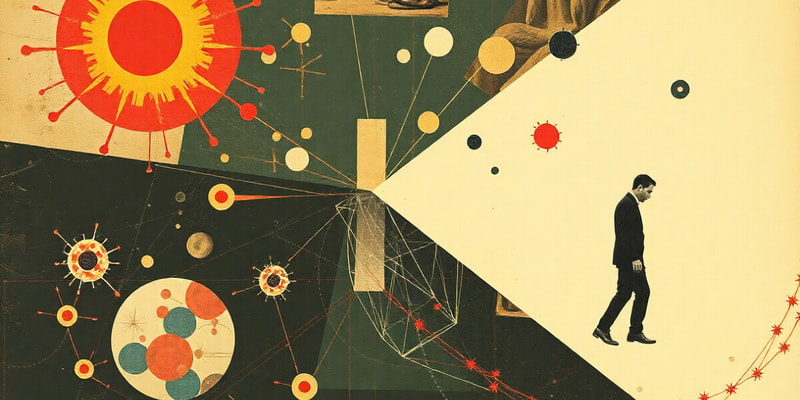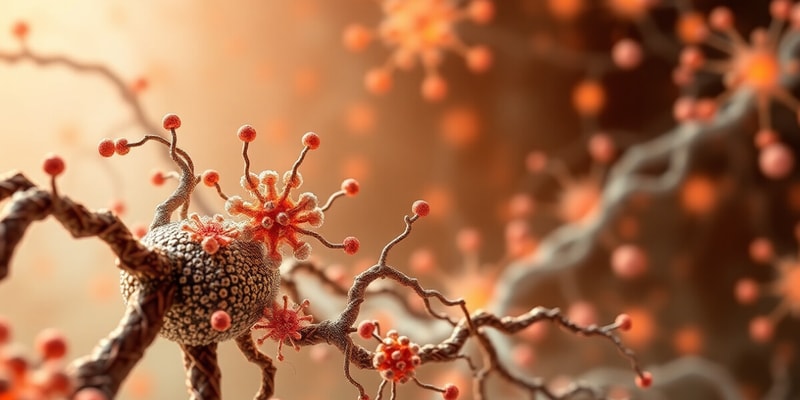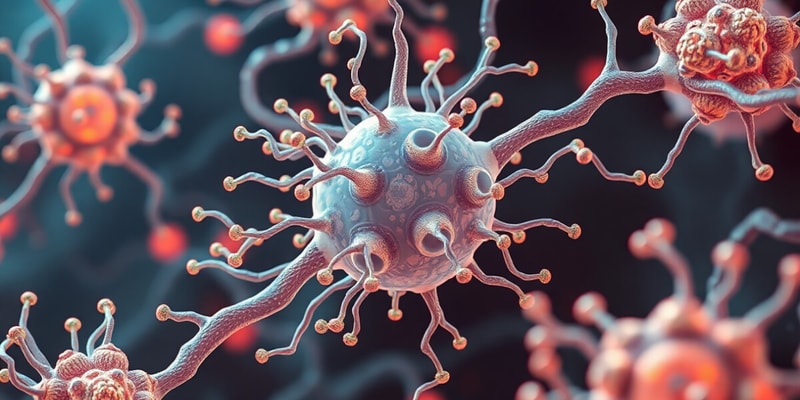Podcast Beta
Questions and Answers
What role does phosphorylation play in the context of T cell activation?
Which transcription factors are identified as critical for T cell responses after antigen recognition?
What is a consequence of signaling molecule turnover at the synapse in T cells?
What initiates the phosphorylation of ITAMs in T cells?
Signup and view all the answers
What is implied about the multiple transcription factors activated in T cells?
Signup and view all the answers
What is a primary function of cell surface receptors in the immune system?
Signup and view all the answers
What typically occurs during the cytosolic phase of signal transduction after receptor activation?
Signup and view all the answers
Which process may be required for the initiation of signaling from cell surface receptors?
Signup and view all the answers
What mechanism is primarily responsible for the addition of phosphate groups during signal transduction?
Signup and view all the answers
What distinguishes nuclear receptors from cell surface receptors?
Signup and view all the answers
Which step follows the initial cytosolic phase in the signal transduction pathway?
Signup and view all the answers
What is primarily recognized by the extracellular domains of plasma membrane receptors?
Signup and view all the answers
What common event often occurs early in the signal transduction process?
Signup and view all the answers
What is the main function of non-receptor tyrosine kinases in relation to non-receptor tyrosine kinase receptors?
Signup and view all the answers
Which of the following is NOT a characteristic of receptor tyrosine kinases (RTKs)?
Signup and view all the answers
What is the role of ITAM motifs found in immune receptors?
Signup and view all the answers
How do inhibitory receptors in the immune system primarily function?
Signup and view all the answers
Which structural characteristic is unique to the T cell receptor (TCR)?
Signup and view all the answers
What components make up the antigen-binding portion of the T cell receptor?
Signup and view all the answers
Which receptor is an example of an inhibitory receptor found on B cells?
Signup and view all the answers
What is a defining feature of nuclear receptors compared to other types of receptors?
Signup and view all the answers
What is a key feature of non-receptor tyrosine kinases in cellular signaling?
Signup and view all the answers
How are receptor tyrosine kinases (RTKs) activated?
Signup and view all the answers
What type of molecules primarily influence the function of nuclear hormone receptors?
Signup and view all the answers
What is the primary role of G protein-coupled receptors (GPCRs)?
Signup and view all the answers
In what way do Notch receptors influence cell fate determination?
Signup and view all the answers
Which of the following is NOT a function of nuclear receptors?
Signup and view all the answers
Which receptor category is specifically involved in activation through GDP-GTP exchange?
Signup and view all the answers
What process is directly associated with the activation of Notch receptors?
Signup and view all the answers
What is the primary role of the hypervariable regions in TCR?
Signup and view all the answers
Which statement correctly describes the interaction of CD4 and CD8 with MHC molecules?
Signup and view all the answers
What is the composition of most CD8 molecules?
Signup and view all the answers
How many complementarity-determining regions (CDRs) are present in the TCRs of mature αβ T cells?
Signup and view all the answers
What characterizes the immune synapse?
Signup and view all the answers
What structural feature is shared by the CD4 and CD8 coreceptors?
Signup and view all the answers
What is true about the cytoplasmic tail of the CD4 coreceptor?
Signup and view all the answers
Which of the following is not a role of the TCR complex during T cell activation?
Signup and view all the answers
Study Notes
Cell Surface Receptors
- Cells have specific surface receptors that can be triggered by external ligands.
- Cell surface receptors have several functions:
- Induction of intracellular signaling leading to cell activation.
- Adhesion of one cell to another or to the extracellular matrix.
- Internalization of extracellular molecules and cells.
- The initial stage of signaling involves enzymatic modification of the cytoplasmic portion of the receptor or interacting proteins.
- This leads to the activation or nuclear translocation of transcription factors, followed by the regulation of gene expression.
Signal Transduction
- Receptors initiate responses on the plasma membrane by recognizing soluble secreted ligands or membrane-bound structures on neighboring cells or the extracellular matrix.
- Nuclear receptors are found intracellularly and are activated by lipid-soluble ligands that can cross the plasma membrane.
- Ligand-induced clustering of receptor proteins, known as cross-linking, or conformational changes induced by ligand association can trigger signaling.
Receptor Tyrosine Kinases (RTKs)
- Integral membrane proteins with intrinsic tyrosine kinase domains in their cytoplasmic tails.
- Activation occurs when multivalent extracellular ligands cross-link the receptors.
Non-Receptor Tyrosine Kinases
- Ligand-binding polypeptides lack intrinsic catalytic activity.
- A separate intracellular tyrosine kinase, known as a non-receptor tyrosine kinase, participates in receptor activation by phosphorylating specific motifs on the receptor or associated proteins.
Nuclear Receptors
- Typically located in or migrate into the nucleus, functioning as transcription factors.
- Can influence a range of events, from immune system development to modulation of cytokine gene expression.
- Examples include the vitamin D receptor and the glucocorticoid receptor.
G Protein-Coupled Receptors (GPCRs)
- Activate associated GTP-binding proteins (G proteins).
- Ligand binding induces a conformational change that activates the G protein by exchanging bound GDP with GTP.
- Examples relevant to immunity and inflammation include receptors for leukotrienes, prostaglandins, histamine, complement fragments C3a and C5a, and all chemokines.
Receptor Proteins of the Notch Family
- Involved in development across a wide range of species.
- Ligand association leads to proteolytic cleavage of the receptor and nuclear translocation of the cleaved cytoplasmic domain (intracellular Notch), which acts as a component of a transcription complex.
- Involved in cell fate determination during lymphocyte development and may influence the activation of mature lymphocytes.
Immune Receptor Family
- Immune receptors that activate immune cells have separate polypeptide chains for recognition and associated chains containing cytosolic Immunoreceptor tyrosine-based activation motifs (ITAMs).
- The B cell receptor (BCR), the T cell receptor (TCR), and the high-affinity receptor for IgE (FcεRI) have ITAM motifs.
- Inhibitory receptors often have ITIM motifs within the same chain that recognizes ligands.
- FcγRIIB is an inhibitory receptor found on B cells and myeloid cells, while PD-1, an inhibitory receptor on T cells, has an immunotyrosine-based "switch" motif in its cytoplasmic tail.
T Cell Receptor for Antigen
- The antigen receptor of MHC-restricted CD4+ helper T cells and CD8+ cytotoxic T lymphocytes (CTLs) is a heterodimer consisting of two transmembrane polypeptide chains, TCR α and β, linked by a disulfide bridge.
- The antigen-binding portion of the TCR is formed by the Vβ and Vα domains.
- The hypervariable segment loops that form the peptide-MHC binding site are at the top.
Binding of TCR to an MHC Molecule
- The V regions of the TCR α and β chains contain short stretches of amino acids with concentrated variability, forming the hypervariable or complementarity-determining regions (CDRs).
- Three CDRs in the α chain and three in the β chain form the part of the TCR that specifically recognizes peptide-MHC complexes.
Components of the TCR Complex
- CD4 and CD8 are T cell coreceptors that bind to nonpolymorphic regions of MHC molecules and facilitate signaling by the TCR complex during T cell activation.
- Mature αβ T cells express either CD4 or CD8, not both.
- CD8 interacts with class I MHC molecules, while CD4 interacts with class II MHC molecules, leading to the class I or class II MHC restriction of these T cell types.
Role of the CD4 and CD8 Coreceptors in T Cell Activation
- CD4 has four extracellular Ig-like domains, a transmembrane region, and a basic cytoplasmic tail.
- The two N-terminal Ig-like domains of CD4 bind to the α2 and β2 domains of the class II MHC molecule.
- Most CD8 molecules are heterodimers of CD8α and CD8β chains.
- Both chains have a single extracellular Ig domain, a transmembrane region, and a basic cytoplasmic tail.
The Immune Synapse
- A stable contact between an antigen-specific T cell and an APC displaying that antigen.
- It becomes the site for assembling the T cell's signaling machinery, including the TCR complex, coreceptors, costimulatory receptors, and adaptors.
- Facilitates prolonged and effective T cell signaling.
- Ensures the specific delivery of secretory granule contents and cytokines from a T cell to APCs or target cells.
- May be a site for the turnover of signaling molecules, contributing to the termination of T cell activation.
Signal Transduction
- Phosphorylation of proteins and lipids plays a central role in TCR complex and coreceptor signaling.
- There is some basal tyrosine phosphorylation of ITAM tyrosines and recruitment of ZAP-70 before TCR activation.
- Lck phosphorylates ITAMs of the CD3 and ζ chains within seconds of TCR ligation.
Activation of Transcription Factors That Regulate T Cell Gene Expression
- Different transcription factors are activated by different cytoplasmic signal transduction pathways.
- Multiple transcription factors are needed because many signaling pathways are activated after antigen recognition.
- Three transcription factors that are activated in T cells by antigen recognition and appear to be critical for most T cell responses are nuclear factor of activated T cells (NFAT), AP-1, and NF-κB.
Studying That Suits You
Use AI to generate personalized quizzes and flashcards to suit your learning preferences.
Related Documents
Description
Explore the roles and functions of cell surface receptors in signaling processes. This quiz covers key concepts including ligand interactions, receptor activation, and the regulation of gene expression via signal transduction pathways. Test your understanding of how these mechanisms work at the cellular level.




